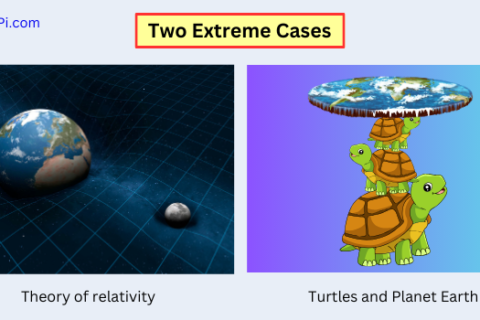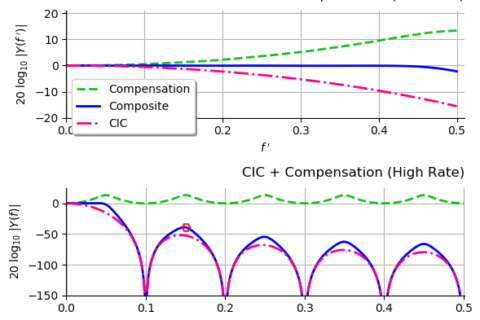In the tutorial on how complex numbers arose, we asked three questions. The first two were answered in the same article while the answer to the third question, repeated below, is explained here.
Why is the expression $e^{i \theta}$ a rotation of 1 by $\theta$ radians on a unit circle? Is it possible to make sense out of a number like $2.71828^{\sqrt{-1}\cdot\theta}$?
The constant e is a special number discovered by Jacob Bernoulli while studying compound interests. It appears in many other forms as well which are all related to each other but that topic is a complete account in itself and hence outside the scope of this guide. Here, we will learn about $e$ in a simple manner.
Jill and the Beanstalks
Imagine that the mysterious man who gave Jack the seeds takes Jill to his magical garden and shows her several beanstalks with an offer. The height of each beanstalk is exactly one imaginary meter. At midnight, the magic will return after tending to Cinderella’s affairs and all of them will start growing until the morning arrives.
- The first beanstalk will grow by $1$ imaginary meter all in one burst at the end of the night, a growth of $100\%$.
\[
(1+1) = 2
\] - For the second beanstalk, the duration of growth is divided into two equal halves. It will grow by $1/2$ $=$ $50\%$ at the end of the first half which comes out to be $(1+0.5)=1.5$ imaginary meters. Then, it will grow by another $1/2=50\%$ at the end of the second half. Since the initial height at the start of this second half is $1.5$ imaginary meters (instead of $1$ imaginary meter), its final value would be given by
\[
1.5 \left(1+\frac{1}{2}\right) =\left(1+\frac{1}{2}\right)\cdot \left(1+\frac{1}{2}\right) = 2.25
\]
This growth of beanstalks in successively smaller partitions is illustrated in Figure 20. - The third beanstalk will grow by $1/3=33.33\%$ each at the end of $3$ equally separated parts of the night.
\[
\left(1+\frac{1}{3}\right)\cdot \left(1+\frac{1}{3}\right) \cdot \left(1+\frac{1}{3}\right) = 2.37
\]
We can think of this process as having attained a height of $1.33$ imaginary meters at the end of first part, to which a further growth factor of $(1+0.33)$ acts in the second part. This produces an initial value of $(1.33)\cdot(1.33)$ $=$ $1.77$ imaginary meters at the start of the third part. As you can easily guess, $1.77$ times $1.33$ for this last part turns out to be $2.37$ imaginary meters.

Figure 20: Growth of beanstalks in successively smaller partitions
This chain continues for an infinitely many beanstalks in the magical garden. The giant will only die if he falls from a height of $2.72$ imaginary meters. Which beanstalk should Jill climb?
Being good at mathematics, Jill computes the resulting sequence as follows.
\begin{align*}
\left(1+\frac{1}{1}\right)^{1} &=~ 2.00 \\
\left(1+\frac{1}{2}\right)^{2} &=~ 2.25 \\
\left(1+\frac{1}{3}\right)^{3} &=~ 2.37 \\
\vdots \\
\left(1+\frac{1}{1000000}\right)^{1000000} &=~ 2.718280469
\end{align*}
She concludes that no beanstalk, even in a magical garden and with continuous growth, will reach a height of $2.72$ imaginary meters and walks away from the riches. This limiting value is the constant $e$.
\[
e^{1} = \lim_{n\rightarrow \infty} \left(1+\frac{1}{n}\right)^{n} = 2.718281828459045
\]
It is subsequently deduced that $e$ represents a continuous growth for a unit period of time at a rate of $100\%$. What is overlooked here is the following property.
The real power of $e$ becomes visible by writing the above equation in the form
\[
e = \lim_{n\rightarrow \infty} \left(1+\frac{1}{n}\right)^{n}
= \lim_{n\rightarrow \infty} \left(1+\frac{1}{n}\right)\left(1+\frac{1}{n}\right)\left(1+\frac{1}{n}\right)\cdots\cdots \left(1+\frac{1}{n}\right)
\]
Like a machine press, the constant $e$ compresses an infinite number of multiplications into a single quantity!

Figure 21: Like a machine press, the constant $e$ has the power to compress an infinite number of multiplications into a single quantity
Beamforming Perspective
The above description of $e$ does not present the complete picture because it is based on a primitive concept of numbers, specifically the positive real line only as discussed in Section 3.1. Like all other concepts based only on the positive real line, this is bound to result in some pieces gone missing! Let us take this concept forward as follows.
Positive Real Line: As described above, $e$ represents continuous growth for a unit period at a rate of $100\%$. However, this is true for positive real line only exhibited through Figure 22. We encounter new interpretations of $e$ if we alter the direction and/or the axis.
Negative Real Line: In the reverse direction, the change is actually a shrinkage due to the negative sign as illustrated in Figure 22.
\begin{align*}
\left(1+\frac{-1}{1}\right)^{1} &=~ 0.00 \\
\left(1+\frac{-1}{2}\right)^{2} &=~ 0.25 \\
\left(1+\frac{-1}{3}\right)^{3} &=~ 0.296 \\
\vdots \\
\left(1+\frac{-1}{1000000}\right)^{1000000} &=~ 0.3678
\end{align*}

Figure 22: Radiation pattern of a directional antenna is similar to the directivity of the constant $e$
It is evident that this sequence converges to $e^{-1}=1/e=0.367879441$. It can be concluded that $e$ is a directional constant for a continuous process and not a simple growth. This direction is controlled by the representative member of any axis such as $(-1)^0$ for positive real line and $(-1)^1$ for negative real line. I often imagine this property of $e$ as similar to radiation pattern of a directional antenna or beamforming for spatial filtering of wireless or audio signals by an antenna array. This is plotted in Figure 22 where $e$ represents growth by a factor of $2.718$ for direction defined by $(-1)^0=1$ and shrinkage by a factor of $0.368$ for direction defined by $(-1)^1=-1$. Consequently, its behaviour towards the imaginary axis defined by $(-1)^{0.5}$ must be somewhere between these two extremes. Could it be simply $1$? Let us find out.
Positive Imaginary Line: We can extrapolate from the above discussion that $e$ can become a part of complex number notations if the direction factor is replaced by $(-1)^{0.5}=\sqrt{-1}$. Nevertheless, it is not immediately clear what exactly are the far reaching implications of this representation. This is what we discuss next.
Forging a Complex Form
We have already established that $(-1)^{0.5}$ is simply a rotation of $90^{\circ}$ in a complex plane. Consider a complex number $z$ with an angle $\theta$ on the unit circle shown in Figure 23. On a side note, I could use $\theta=1$ radian here to be more precise but then too many $1$s in an expression can confuse the reader. And hence it seems better to go ahead with an angle $\theta$. From simple trigonometry, $z$ has the rectangular form
\begin{equation*}
z = (z_R, z_I) = 1\cdot \cos \theta + (-1)^{0.5} \cdot 1\cdot \sin \theta = \cos \theta + i \cdot \sin \theta
\end{equation*}

Figure 23: A complex number $z$ with unit magnitude and angle $\theta$
Notice the two ways of expressing a complex number above.
- An ordered pair $(z_R, z_I)$ in a 2D plane.
- A rectangular form $z_R+(-1)^{0.5} \cdot z_I$ $=$ $z_R + i\cdot z_I$.
The first expression above is similar to the way we represent a point in 2D geometry. The second is a unique complex numbers terminology that works with simple arithmetic rules. Did you notice something peculiar here? None of them represents a complex number as a single quantity! Such a representation is important because it simplifies many of the lengthy trigonometric computations involving sines and cosines.
One such way to represent a complex number is to combine magnitude and phase to write it as $z=r \measuredangle \theta$. But it is still an ad hoc suggestion instead of a solid number in a 2D plane. This is where $e$ enters the picture through its property of compressing an infinite number of multiplications into a single quantity.
\[
e = \lim_{n\rightarrow \infty} \left(1+\frac{1}{n}\right)^{n}
= \lim_{n\rightarrow \infty} \left(1+\frac{1}{n}\right)\left(1+\frac{1}{n}\right)\left(1+\frac{1}{n}\right)\cdots\cdots \left(1+\frac{1}{n}\right)
\]
The clue here is to reach the angle $\theta$ of $z$ in Figure 23 through an infinite number of rotations, each of which can be an infinitesimally small (e.g., $\theta/n$ for large $n$). But what to do when the power of $e$ lies in multiplications, not rotations?
In the end, our quest comes down to searching for a complex multiplicative factor that rotates a complex number by an infinitesimally small angle $\theta/n$ — without changing its magnitude! Infinite such multiplications then rotate that number by any desired angle and allow the number $e$ to play the starring role.
For this purpose, I very quickly summarize the multiplication of two complex numbers, say $y_R+i \cdot y_I$ and $3+i \cdot 2$, keeping in view the fact that $i$ rotates a number by $90^{\circ}$ in the complex plane.
\[
\left\{y_R+i \cdot y_I\right\}\cdot \left\{3+i \cdot 2\right\} = \underbrace{3y_R-2y_I}_{\text{aligned terms}} + i \cdot \underbrace{\left(3y_I + 2y_R\right)}_{\text{cross terms}}
\]
- As drawn in Figure 24, there are two cross terms that fall on the imaginary axis, $3y_I$ and $2y_R$.
- There are two aligned terms that fall on the real axis, $3y_R$ and $-2y_I$ where the minus sign is due to the double $90^{\circ}$ rotation by $(-1)^{0.5}=i$.

Figure 24: Multiplication of two complex numbers generates four real products, two cross terms along the imaginary axis and two aligned terms along the real axis
Now consider an initial point $A$ with the following coordinates illustrated in Figure 25a.
\[
A = (1,0) = 1 + i \cdot 0
\]
This point $A$ has a magnitude of $1$ and it needs to be rotated through an angle $\theta/n$ to point $B$. Observe from Figure 25a that this point $B$ $=$ $(\cos \theta/n, \sin \theta/n)$ coincides with the point $(1,\sin \theta/n)$ $\approx$ $(1,\theta/n)$ if the imaginary part $\theta/n$ is small due to small angle approximation $\cos \phi \approx 1$ and $\sin \phi \approx \phi$ as $\phi \rightarrow 0$. In other words, the angle $\theta/n$ is so narrow that the arc generated by this rotation is approximately equal to the perpendicular line with height $\theta/n$ and the two blue points in Figure 25a merge together. Owing to unit magnitude of $A$, point $B$ can be written as

Figure 25: Complex rotations and the construction of successive angles formed by a product of the previous number with $1+i\cdot \frac{\theta}{n}$
\[
B = \left(\cos \frac{\theta}{n} +i \cdot \sin \frac{\theta}{n}\right)A \approx \underbrace{\left(1+i\cdot \frac{\theta}{n}\right)}_{\text{rotation}}A = 1+i\cdot \frac{\theta}{n}
\]
From the above equation, the rotating multiplicative factor is
\[
1+i\cdot \frac{\theta}{n} = 1+\sqrt{-1}\cdot \frac{\theta}{n}
\]
Following a similar reasoning, point $C$ in Figure 25b is reached through rotating point $B$ by the same factor while another such multiplication takes us to the point $D$.
\begin{align*}
C &= \left(1+i\cdot \frac{\theta}{n}\right)B = \left(1+i\cdot \frac{\theta}{n}\right)^2 \\
D &= \left(1+i\cdot \frac{\theta}{n}\right)C = \left(1+i\cdot \frac{\theta}{n}\right)^3
\end{align*}
This rotation chain continues until we reach point $z$ given by
\[
z = \left(1+i\cdot \frac{\theta}{n}\right)^n = \left(1+\frac{i\cdot \theta}{n}\right)^{\frac{n}{i\cdot \theta}(i\cdot \theta)}
\]
In the limit $n \rightarrow \infty$, this expression becomes
\[
z = \left\{\lim _{n\rightarrow \infty} \left(1+\frac{i\cdot \theta}{n}\right)^{\frac{n}{i\cdot \theta}}\right\}^{i\cdot \theta} =~ e^{i\cdot \theta} ~=~ 2.71828^{\sqrt{-1}\cdot\theta}
\]
Here we have a complex number $z$ expressed in a single quantity on which regular arithmetic operations can be applied without any special definitions. This becomes the force behind the supremacy of complex numbers borrowed from the compressing power of $e$. Had we not invented such a form, complex numbers would probably not have dominated the science world in a manner that led the famous Richard Hamming claim: "God made the universe out of complex numbers!"
Three comments are in order here.
- Let us now plug the angle $\theta=1$ radian in the expression above. From Figure 25b, a simple interpretation of $e^{\sqrt{-1}}=e^i$ is that the number $e=2.71828$ in the direction $\sqrt{-1}=(-1)^{0.5}=i$ neither grows nor shrinks the unit input. It simply stays between these two extremes and rotates the number $1$ by an angle of $1$ radian on the unit circle!
- For a general angle $\theta$, $e^{\sqrt{-1}\cdot \theta}=e^{i\theta}$ rotates by the specified angle due to unit multiplication $1\cdot \theta = \theta$. This is similar to expressing $e^{1/2}$ as a growth rate of $50\%$ in the direction $1$.
- The complex number $z=e^{i\theta}$ has a unit magnitude. By extension, any other number on the complex plane with a magnitude $r$ and angle $\theta$ can be represented as $r e^{i\theta}$ due to the multiplicative nature underneath the definition of $e$.
With this result, we have answered the question: “Why is the expression $e^{i \theta}$ a rotation of 1 by $\theta$ radians on a unit circle? Is it possible to make sense out of a number like $2.71828^{\sqrt{-1}\cdot\theta}$?”
The Most Beautiful Equation
Comparing $z=2.71828^{\sqrt{-1}\cdot\theta}=e^{i\theta}$ with the rectangular form of $z$ $=$ $(\cos \theta, \sin \theta)$, we get the Euler’s identity.
\[
e^{i\theta} = \cos \theta + i\cdot \sin \theta
\]
Furthermore, plugging in $\theta = \pi$ yields
\[
e^{i\pi} = \cos \pi + i\sin \pi = -1
\]
leading to what is commonly known as the most beautiful equation in mathematics.
e^{i\pi} + 1 = 0
\]
This is because the equation connects five famous constants in mathematics, namely $0$, $1$, $e$, $\pi$ and $i$, through single uses of the notions of addition, multiplication, exponentiation and equality.



